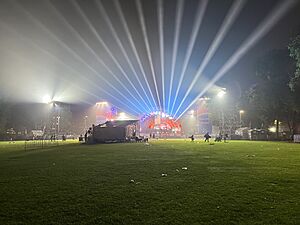Hatch Memorial Shell facts for kids

The Boston Pops performing at the Hatch Shell on July 4, 2005
|
|
| Former names | Edward A. Hatch Memorial Shell |
|---|---|
| Location | Boston, Massachusetts |
| Coordinates | 42°21′26″N 71°04′25″W / 42.357311°N 71.073687°W |
| Owner | Department of Conservation and Recreation |
| Type | Outdoor amphitheater |
| Seating type | open |
| Capacity | 10,000 |
| Opened | 1928 |

The Edward A. Hatch Memorial Shell, often called the Hatch Shell, is a famous outdoor stage in Boston, Massachusetts. It's located by the Charles River Esplanade in the city's Back Bay area. This cool building was finished in 1940 and is a great example of Art Deco style.
Many people know the Hatch Shell because the Boston Pops orchestra plays there every year. They perform for Boston's big Fourth of July celebration. But it's also used for many free concerts and events during the summer. The grassy area in front of the stage doesn't have seats, so people bring blankets or chairs. There's also a special memorial nearby for Arthur Fiedler, who was the first main conductor of the Boston Pops.
Contents
What's in a Name?
The Hatch Shell is named after Edward Hatch. His family had lived in Massachusetts for a long time and made a lot of money from trading with other countries. Edward Hatch passed away in 1910. His sister, Maria, passed away in 1926 and left a large part of her money in a special fund. This money was meant to create "a park, playground or memorial" in or near Boston. It was supposed to be a beautiful place open to the public.
The person in charge of Maria Hatch's money passed away before the plan could be finished. So, the money and its purpose were forgotten until 1936. That's when Massachusetts Attorney General Paul A. Dever found the trust. New people were chosen to manage the money. They decided that building a permanent concert stage on the Charles River Esplanade would be the perfect way to use the money.
A Look at Its History
Early Stages of the Shell
The very first stage was made of wood and built in 1928. It was only meant to be temporary, as everyone hoped a permanent one would be built soon. The Boston Pops Orchestra played its first concert there on July 4, 1929, with Arthur Fiedler leading the music. A second temporary stage, this time made of metal, was built in 1934.
Building the Permanent Hatch Shell
The permanent Hatch Shell was designed by an architect named Richard J. Shaw. It was officially opened on July 2, 1940. Before its 50th birthday in 1991, the shell got a big makeover. It was repaired and its sound system was updated by a Boston architecture company. A skilled craftsman from Boston, Howard Brickman, even rebuilt the detailed wood panels inside the shell by hand.
A large bronze statue of George S. Patton stands nearby. It was made by James Earle Fraser. This statue remembers when General Patton gave a speech at the site on June 7, 1945. About 20,000 people came to hear him speak.
Modern Uses and Updates
Today, the Hatch Shell is used for many different things. You can find concerts, outdoor movie showings, and speeches there. It's also a meeting place for big events, like the AIDS Walk Boston and the Larry Kessler 5K Run. The grassy area in front is a popular spot for picnics, playing casual sports, and sunbathing, just like other parks in the city.
The Hatch Shell had a major renovation in 2018. This was the first big update since 1989. The outside panels of the shell were replaced. To do this, workers had to use a laser to scan the shell. Then, they made 673 separate panels in 93 different shapes to fit perfectly.
How the Hatch Shell Looks
The Hatch Shell is built with a wood frame. It has a large, curved opening that is about 40 feet (12 meters) high and 110 feet (33.5 meters) wide. In front of this opening is a stone platform with stairs. This platform makes the structure about 160 feet (49 meters) wide.
On the front of this platform, you can see the names of famous composers carved into the stone. The outside of the shell is covered in terrazzo tile, which is a mix of chips of marble, quartz, granite, or glass. The inside is finished with wood. The floor inside the shell has steps that curve in a half-circle shape. Around the outside of the shell, there's a flat-roof building. This building holds dressing rooms and storage areas for performers.
- Front
- Half left
- Half right
- Rear
-
- COUPERIN DINDY ELGAR DELIBES WOLF BUXTEHUDE BYRD CORELLI LASSO SCARLATTI VIVALDI BOCCHERINI CHERUBINI GRETRY LULLY BORODIN BRUCKNER CHABRIER SMETANA DUKAS FAURE GLAZUNOV RESPIGHI ROUSSEL SCRIABIN BELLINI DONIZETTI HUMPERDINCK LEONCAVALLO MASSENET MEYERBEER GILBERT GRIFFES HADLEY MASON ALBENIZ AUBER RUBINSTEIN STRAVINSKY SIBELIUS RAMEAU PURCELL MAHLER SOUSA PAINE
-

